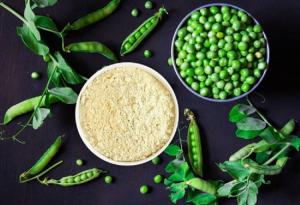Pea Protein Market Top Companies Analysis To reach $176.03 Million Your Business by 2025
Rising health consciousness, soaring multiple health benefits, and increasing demand for meat protein alternatives have increased the demand for pea protein
PORTLAND, OR, UNITED STATES, November 29, 2021 /EINPresswire.com/ -- Pea Protein Market by Type, Form, and Application: Global Opportunity Analysis and Industry Forecast, by 2025, the global pea protein market is projected to reach $176.03 million by 2025, registering a CAGR of 23.6% from during forecast period. The pea protein isolate segment accounted for more than half share of the global pea protein market in terms of value.
High nutritional profile of pea proteins, high demand for plant-based proteins from vegan population, and consistent growth in food & beverages industry have fueled the growth of the global pea protein market. On the other hand, increasing market penetration of other proteins, formulation challenges in pea protein products, and low consumer awareness about the same have restrained the growth to some extent. Nevertheless, rising demand for pea-protein-based sports nutrition & weight management products and growing use of pea proteins as alternative protein source for pet foods have created multiple opportunities in the segment.
Download Free Report Sample@ https://www.alliedmarketresearch.com/request-sample/4727
Pea protein is extracted from green and yellow peas and is used in some protein supplements and protein-enriched foods. Pea protein contains all the essential amino acids required for healthy body function. It helps in doing weight management, improving blood circulation and calcium absorption, maintaining healthy muscle, boosting metabolism, and regulating blood sugar. Pea protein is lactose-free and is safe for people with allergies or sensitivities to dairy and eggs. Thus, vegetarians and vegans prefer pea protein products to supplements with protein derived from dairy, such as casein, whey proteins, eggs, or meat.
The use of pea protein as an alternative for other protein and non-protein ingredients in numerous applications, such as dietary and nutritional supplements, meat alternatives and extenders, snacks, beverages, and other bakery and confectionery goods by food industries, also drives the sales for the global pea protein market. Other factors, such as rising living standards, increasing demand for healthy and nutritional products, growing economy, and soaring urbanization, are indirectly influencing the growth of the global pea protein market in a positive way. However, low consumer awareness about the pea protein-based products and market penetration of animal protein and other plant-based proteins, such as soy, rice, wheat, and others, hampers the growth of this market to some extent. Formulation challenges in pea protein products is also a major factor hindering the growth of the pea protein market. Pea protein is a great source of Iron and Lysine, which help support muscle growth and a healthy immune system. It also contains amino acids essential for healthy body function, and it is easily digestible. Most of the pet/domesticated animal owners ensure that their pets are fed on nutritious feed to avoid diseases and prevent nutrition deficiency. Inclusion of pea proteins as an alternative protein source for pet foods has been an area of focus for most of the pet feed manufacturers, which is expected to provide ample of opportunities for the pea protein industry.
In terms of value, Asia-Pacific and LAMEA collectively contributed more than 30% share in the global market in 2017. The key players operating in the pea protein market are A&B Ingredients, Roquette Freres Le Romarin, Burcon Nutrascience Corporation, Cosucra Groupe Warcoing SA, Glanbia, Plc., The Green Labs LLC, GEMEF Industries, Axiom Foods, Inc., Puris and Yantai Shuangta Food Co., Ltd.
Interested to Procure The Data? Inquire here at: https://www.alliedmarketresearch.com/purchase-enquiry/4727
Key Findings of the Pea Protein Market:
• The pea protein isolate segment was the highest contributor to the market in 2017, and is projected to grow at a CAGR of 22.8%.
• The dry based pea protein segment accounted for 72.14% and is expected to grow at the CAGR of 23.4% from 2018 to 2025.
• The Asia-Pacific region accounted for 18.70% of the pea protein market share in the global pea protein market in 2017 and is projected to grow at a significant CAGR of 25.0%.
• In 2017, China accounted for the highest pea protein market share accounting approximately for 23.1% in the Asia-Pacific region.
• In 2017, the dietary supplement segment generated the highest market share and is expected to grow at significant CAGR of 24.2%.
• The meat products & alternatives segment accounted for almost 12% share of the pea protein market in 2017.
Similar Reports:
Beta Glucan Market: https://www.alliedmarketresearch.com/beta-glucan-market-A06680
Soy Flour Market: https://www.alliedmarketresearch.com/soy-flour-market-A07479
David Correa
Allied Analytics LLP
+1 800-792-5285
email us here
Visit us on social media:
Facebook
Twitter
LinkedIn

